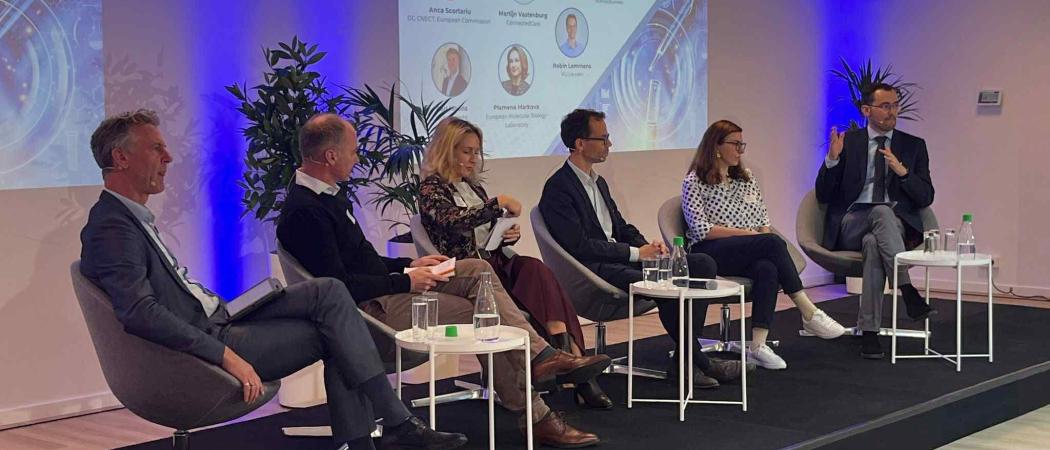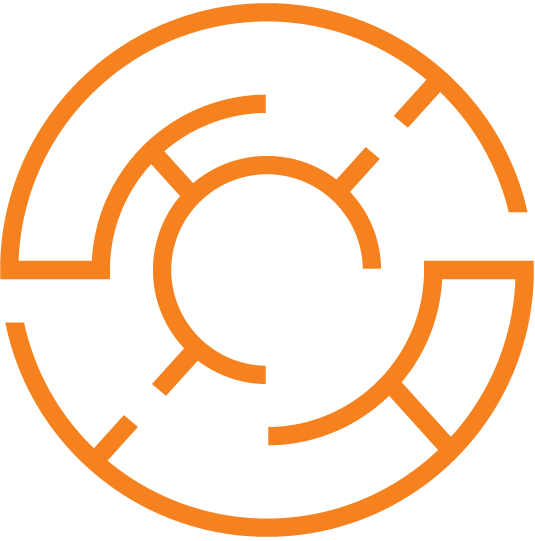Europe aims to boost its global competitiveness in health and life sciences by developing human-centred and highly-personalised AI-based solutions

From left: Carl Moons (UMC Utrecht), Martijn Vastenburg (ConnectedCare), Plamena Markova (EMBL), Robin Lemmens (KU Leuven) and Anca Scortariu (European Commission).
Europe may struggle to match the AI dominance of the US and China across many sectors, but its strength in health and life sciences research suggests it could assume a leadership role in these areas.
To make Europe the place to develop trustworthy and advanced solutions, the European Commission has set up an action plan that builds on five pillars: computing power, data, talent, streamlining regulation, and supporting the deployment and the uptake of solutions.
Last month, the European Commission adopted the AI in Science strategy to develop unified guidelines and methods that can be shared among healthcare professionals across the EU, supporting the deployment of AI solutions in hospitals. The uptake of such innovations is only possible if patients and healthcare providers have trust in them.
“To build trust, you need evidence — you need to show that these solutions work, and you need clear processes for certifying AI-enabled medical devices. That is precisely what this initiative seeks to achieve,” Anca Scortariu, deputy head of unit for AI in Health and Life Sciences at the European Commission, told the Healthy competition: Can Europe regain its global edge in life sciences? conference, hosted by Science|Business on October 16.
However, the EU will need to overcome several challenges. Speakers pointed to slow regulatory processes, differences in interpretation among EU member states, and a shortage of professionals who can bridge the gap between research and clinical practice. “We know that 19 EU member states have AI strategies that mention healthcare as a priority sector,” Scortariu said. “But not all of them include concrete measures to turn this vision into reality or to support adoption.” This gap between innovation and uptake, she added, is what the European Commission hopes to close through new incentives and coordination efforts.
AI may have entered healthcare later than other industries, but experts say its potential to transform the sector is huge, particularly when it comes to making care more personal, effective and safe.
AI can perform routine tasks faster and more efficiently than humans, freeing up time for healthcare professionals to focus on patients rather than paperwork. According to Carl Moons, professor at University Medical Center (UMC) Utrecht, about 40% of clinical professionals’ work is administrative, and AI could change that. “In the end, we're all patients, only we don't know yet, but predicting what disease we're going to develop with AI, that's the future, making it much more personal,” Moons said.
Turning research into real-world impact
EU-funded programmes are already supporting the development of AI technologies for healthcare through the Horizon Europe research initiative. Under the Stay Healthy cluster, several projects are pioneering ways for AI to make a measurable difference in people’s lives.
One such initiative is SmartChange, introduced by Martijn Vastenburg, founder and managing director at ConnectedCare. The project focuses on predicting and reducing the risk of chronic diseases (such as tuberculosis, diabetes, heart failures, etc)in children and adolescents. It includes tools that generate AI-based risk predictions for healthcare professionals, as well as an app featuring gamification and educational elements for citizens. “Children live in the here and now, and they’re not thinking about how eating unhealthily today might affect their risk of disease when they’re 40 years old,” Vastenburg said. In that context, the goal of SmartChange is to develop advanced AI solutions that resonate with the user group.
Another project, TRUSTroke, is an AI-based platform designed to assist patients and healthcare professionals in managing both the acute and chronic phases of stroke. According to Robin Lemmens, professor and head of the Specialised Programme for Academic Consultants at KU Leuven, one in four adults will experience a stroke, a condition associated with high mortality and morbidity rates. “Many people continue to suffer from the consequences of a stroke, even when they survive,” Lemmens said. “We believe it’s essential to gain deeper insights into specific endpoints and how we can better predict them — and, of course, to adjust treatment accordingly.” TRUSTroke collects patient data during the first year after a stroke to better understand long-term experiences and needs.
Europe’s competitive strengths
Europe’s strength lies not in scale, but in quality, particularly its well-established research networks and data infrastructures, according to the experts. “It’s not for no reason that one of the biggest U.S. companies came to Europe to collaborate,” said Plamena Markova, chief of international relations at the European Molecular Biology Laboratory. “Europe is strong — it has well-established data infrastructures built over many years. There’s really no equivalent elsewhere.”
Vastenburg agreed that Europe’s approach offers a distinctive edge. “We’re not aiming to build the biggest models or the largest collaborations,” he said. “We have to create the most usable, most trustworthy, and most human-centred solutions — and that’s where our real opportunity lies.”
Markova warned, however, that Europe must safeguard its technological independence. “If Europe doesn’t maintain resilient, open and accessible data systems — ones that aren’t vulnerable to geopolitical fragmentation — it won’t be able to capitalise on future breakthroughs,” she said. In a similar vein, some speakers highlighted that realising Europe’s ambitions in health AI depends on access to reliable data, large-scale collaborations, such as Virtual Human Twins, and investments in supercomputing.




 A unique international forum for public research organisations and companies to connect their external engagement with strategic interests around their R&D system.
A unique international forum for public research organisations and companies to connect their external engagement with strategic interests around their R&D system.